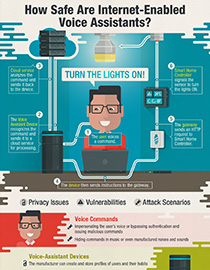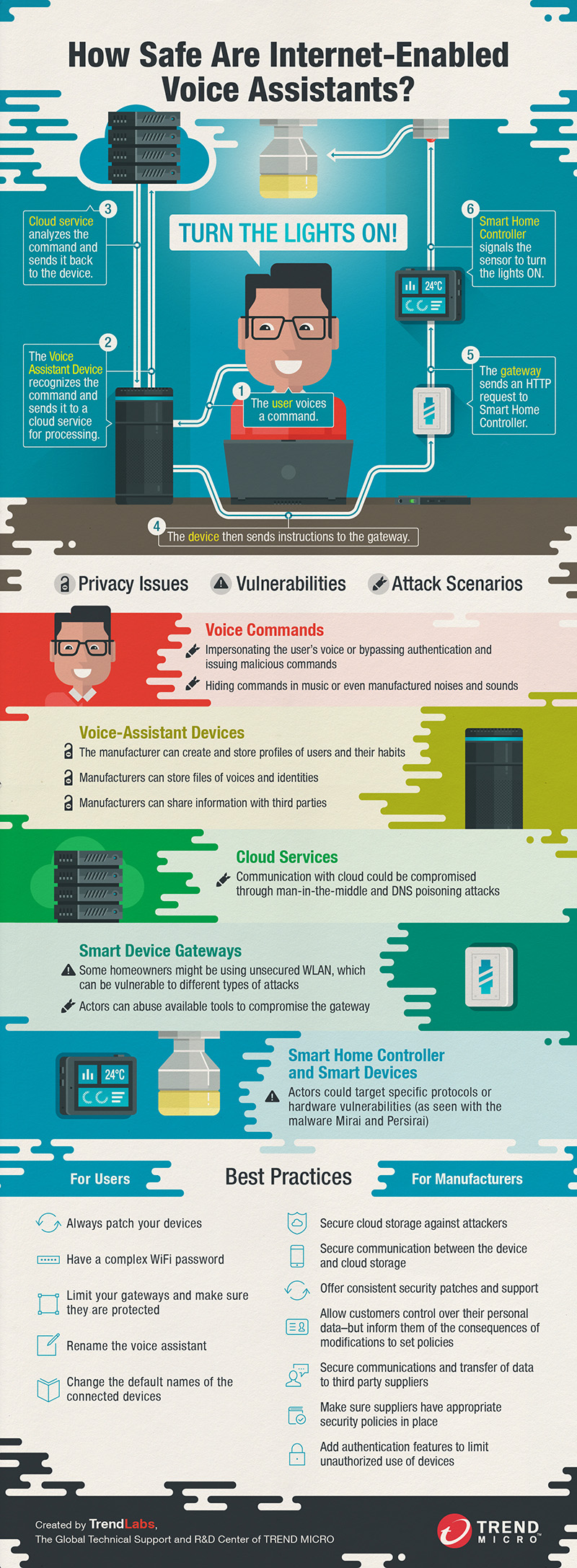How Secure are your Internet-Enabled Voice Assistants?
 View Infographic: How Secure are your Internet-Enabled Voice Assistants
View Infographic: How Secure are your Internet-Enabled Voice Assistants
Households all over the world are rapidly adopting conversational user interface (CUI) technology, or the tech behind the voice assistants we know as Siri, Alexa, Cortana, and Google Assistant. Reports say that over 24 million voice-enabled machines were shipped in 2017, and the growth shows no sign of stopping. As more of these devices become available, users are quickly using them to their fullest potential, creating increasingly connected homes.
The ease of speech
We are slowly moving away from the keyboard as the primary input device—why type when you can just use your voice to ask a question or issue a command? But this technology opens up new questions on how voice data can be manipulated and how these devices can be compromised. There are concerns regarding privacy and safety, which is natural since these smart devices control certain home functions. The fact that the devices can listen in on conversations and potentially record them also raises serious privacy issues.
Recent events show that even legitimate corporations are finding unique ways to abuse the devices’ sensitivity to sound. One example involves a popular fast food chain, which crafted an advertisement that deliberately exploited voice assistants to trigger a definition search for their product. It was a blatant and successful exploit of the capabilities of the devices—and not illegal. New technological territory means that there are no rules governing the use of these devices.
There have also been incidents where these devices recorded information or followed commands unintentionally. While this resulted in a fortunate accident in at least one case, it also has its share of downsides. On the manufacturer's side—they can collect and store data, creating user profiles that may be vulnerable. And, of course, there are always malicious attackers who try to exploit the latest technology or look for new ways to steal personal data.
This infographic details the various ways that the devices can be compromised, and also suggests some best practices for users as well as manufacturers. This technology provides convenience and a lot of other benefits to its users, but safety and privacy are crucial issues for any device that is so connected to the home.
Users can take a step in the right direction and install security solutions that protect their voice-enabled devices. Trend Micro™ Home Network Security has web protection and deep packet inspection, leveraging the right capabilities to protect smart voice assistants connected to routers. It offers gateway solutions that can weed out potential threats before they enter the home.

Like it? Add this infographic to your site:
1. Click on the box below. 2. Press Ctrl+A to select all. 3. Press Ctrl+C to copy. 4. Paste the code into your page (Ctrl+V).
Image will appear the same size as you see above.
 Cellular IoT Vulnerabilities: Another Door to Cellular Networks
Cellular IoT Vulnerabilities: Another Door to Cellular Networks AI in the Crosshairs: Understanding and Detecting Attacks on AWS AI Services with Trend Vision One™
AI in the Crosshairs: Understanding and Detecting Attacks on AWS AI Services with Trend Vision One™ Trend 2025 Cyber Risk Report
Trend 2025 Cyber Risk Report CES 2025: A Comprehensive Look at AI Digital Assistants and Their Security Risks
CES 2025: A Comprehensive Look at AI Digital Assistants and Their Security Risks